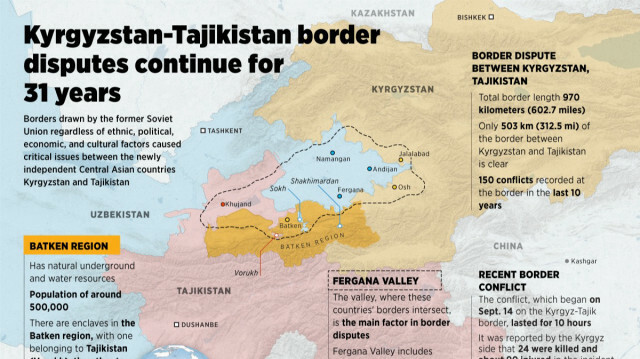
There have been more than 150 conflicts between 2 countries in last 10 years
With the borders drawn by the former Soviet Union regardless of ethnic, political, economic, and cultural factors, the newly independent Central Asian countries Kyrgyzstan and Tajikistan faced each other for 31 years.
The states of Kyrgyzstan and Tajikistan, on the one hand, tried to overcome the economic, political, and social problems with the disintegration of the Union of Soviet Socialist Republics (USSR), on the other hand, they encountered problems related to the borders of the country.
While the search for a solution to the border problem, which is among the priorities of both countries, continues, the search for a solution in the border regions of both countries is in a deadlock due to the geographical situation, ethnic structure, transportation, and water resources.
Tensions often arise between border guards and citizens, due to the density of fertile farmland, undefined territory, illegal crossings, animal grazing, and control of water resources.
- Batken area
The Batken region, bordering Tajikistan and Uzbekistan in the south of the country, is one of the seven regions of Kyrgyzstan with its natural underground and water resources, natural beauty, smooth transit routes and a population of around 500,000.
Located 750 kilometers (466.02 miles) from Bishkek, the capital of Kyrgyzstan, and in the southwest of the country, the Batken region is located on the edge of the famous Fergana Valley in Central Asia.
Fergana Valley includes Fergana, Namangan, Andijan in Uzbekistan, Hocand in Tajikistan, Osh, Jalalabad and Batken in Kyrgyzstan.
The Batken region borders the Republic of Uzbekistan in the northeast and the Republic of Tajikistan in the southwest and north.
There are enclaves in the Batken region, one of which belongs to Tajikistan and the other to Uzbekistan, with a total population of around 100,000.
In the Batken region of Kyrgyzstan, there are the Shahimerdan, Soh, and Voruh enclaves belonging to Uzbekistan.
In this context, since the transportation arteries cross many borders and enclaves, they cause mutual accusations of smuggling and different discussions.
Covering 8.5% of Kyrgyzstan's land, the region has agricultural, underground, water and energy resources, as well as oil and natural gas resources, albeit small.
- Almost half of 2 countries' borders are 'disputed'
Kyrgyzstan and Tajikistan, which have the most complex borders in the region, have not been able to solve this problem for a long time, and the Fergana Valley, where these countries' borders intersect, is the main factor in border disputes.
While only 503 kilometers (312.5 miles) of the 970 kilometers (602.7 miles) border between Kyrgyzstan and Tajikistan is clear, only 47 kilometers (29.2 miles) have been agreed upon in the border demarcation studies that have been ongoing since 2012.
Since the settlements where Kyrgyz citizens live are very close to Tajikistan, Kyrgyz citizens are most affected by the conflicts that broke out due to the border dispute.
The border problems, which became chronic in the independence history of the two countries, have created problems in the neighborly relations for 31 years, causing the lives and property of the conflicting peoples.
- 150 conflicts in last 10 years
In the last 10 years, issues related to land claims, water resources and the use of plateaus have come to the fore in disputes between the two countries.
During this period, more than 150 tensions and conflicts were recorded between the two countries, including loss of life due to the reasons stated above.
The conflict on April 29, 2021, when the biggest loss of life between the two countries was experienced, broke out due to controlling the Golovnoy water distribution network located on the Kyrgyz-Tajik border.
In the conflict between the Kyrgyz-Tajik border guards, 31 Kyrgyz citizens lost their lives, 21 houses, 10 gas stations, a school, two cafes, eight grocery stores and a border post were burned on the Kyrgyz side.
- Last border conflict
The last conflict on the Kyrgyz-Tajik border took place on Sept. 14.
The armed conflict intensified and lasted for exactly 10 hours.
It was claimed that the Tajik side of the conflict took the Kyrgyz border villages of Kulundu, Maksat and Jani-Jer settlements under fire, and that modern weapons and equipment were used in the conflict.
It was reported by the Kyrgyz people that 24 people were killed and about 90 injured in the incident.
Approximately 136,000 people from Kyrgyz villages close to Tajikistan were evacuated to safe places.
Kyrgyzstan declared a state of emergency in the Batken region, where clashes with Tajikistan border guards took place.
The two countries decided to establish a commission to resolve the border dispute, but cease-fire violations are occasionally made at the border.

